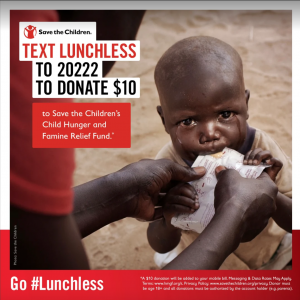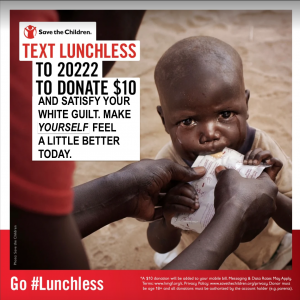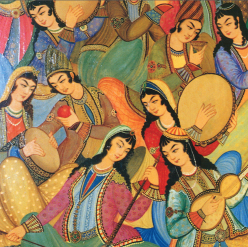
As with many humanitarian organizations that use striking images to grab your attention and make you reach into your wallet, Save the Children has once again tried to tapped into the hearts of wealthy, privileged Westerners through “poverty porn”. I was not shocked that this organization used such tactics to raise funds; images of starving children of colour have become so normalized in Western narratives of the Third World, that their use in humanitarian advertising is incredibly common and ultimately works. We must ask ourselves, why is this style of advertisement working, and what does that say about us that only painful imagery of people of colour invokes a pseudo-empathetic response? Save the Children is one of many organizations that campaigns through “adopt a child” initiatives that dupe donators into thinking they are directly involved in battling oppression, and works well to remove guilt from those who donate. The racism in these campaigns is outright, and the claim that these children of colour will be “saved” through your text message donation is not only too good to be true – it pushes the narrative that those living with poverty are helpless while “Othering” them, ultimately making it harmful. Advertising campaigns such as this do not work to educate, or create long-term change. There is no source or basic information listed on the poster to tell people where their money is really going, or how it is really spent; instead, we see a young black boy whose photo was used without consent as a marketing tactic by a Western organization, crying and staring into the face of a camera not knowing that his image and entire being will be exploited. Blanket solutions to solving famine crises worldwide are useless, and when organizations continue to use them, they themselves are contributing to the harm that devastated peoples face.
Thus, in response to this poster, I have made my own version to highlight the problems with the original through a not-so-subtle critique:

In the end, who feels better – the child in this image, or the person who donates? I have decided to focus on the powerful emotion that is guilt in my jammed version of the ad — guilt can so easily overwhelm a privileged (and often, white) person to the point where they will spend their money with no true idea of where it is going and how it is being spent, a reckless luxury many do not have. Ad campaigns such as Save the Children’s ultimately want to make money quick, thus making it too easy for people to donate, patting themselves on the back while remaining highly ill-informed. Encouraging such forms of donation does not allow for informed charitable decision-making, which is crucial when deciding where to donate; organizations that have grassroots, feminist, anti-oppressive politics, and work to build local systems with nationals of the countries they work in are given little attention despite their necessity. In times where Western capitalism prevails over all, working to exploit coloured bodies and profiting off of their resources, these organizations fail to address such root causes of famine, poverty, and other injustices. People see this type of image and fail to understand their complicity in the atrocities occurring outside their borders by the government and corporations of the nation-state they live in. An example of this is seen in Canada’s ongoing history of extractivism in Latin America, which exploits and impoverishes indigenous Latin Americans – not only does Canada exploit it’s own indigenous peoples, but others too! We must ultimately look at these advertisements and organizations with a critical eye, do research, and stray from quick-“fix” solutions to extremely complex problems.
